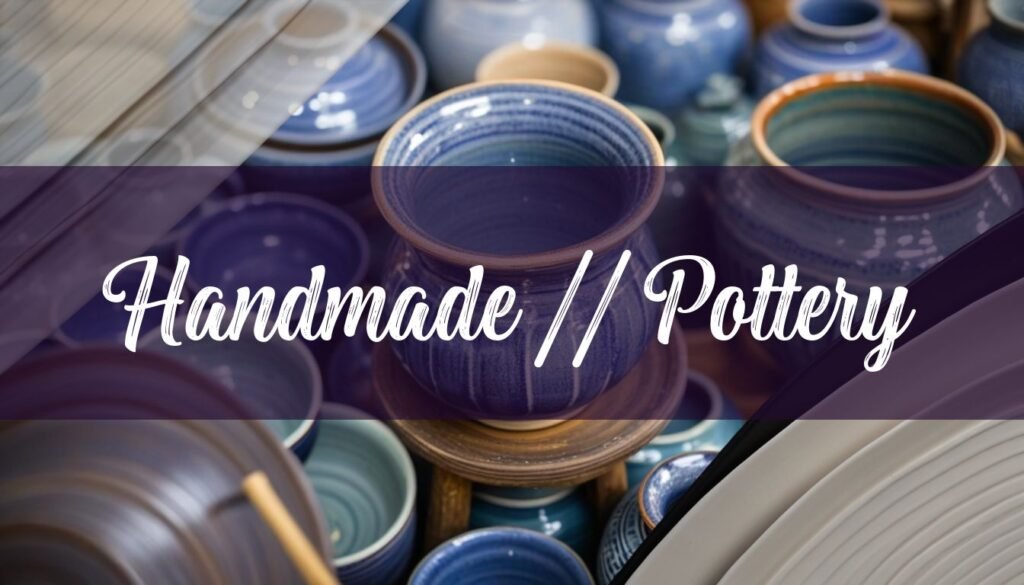Finding that perfect piece of handmade pottery can feel like discovering a hidden treasure. Whether you’re searching for a unique mug to cradle your morning coffee, a statement bowl for your dining table, or a piece of art to adorn your shelves, the world of handmade ceramics offers a wealth of possibilities. This article serves as your guide to navigating the landscape of handmade pottery, helping you find the perfect pieces while appreciating the artistry and craftsmanship behind them.
Where to Buy Handmade Pottery
The quest for handmade pottery can lead you down many paths, each offering a unique experience. One of the most rewarding ways to find handmade pottery is by exploring local artisan shops and craft fairs. These venues provide an opportunity to meet the potters in person, learn about their process, and see their work up close. It’s a chance to connect with the artist and hear the story behind each piece, adding a layer of personal significance to your purchase. You might also find inspiration for your own creations, should you decide to take a pottery class or two.
Online marketplaces like Etsy have revolutionized the way we access handmade goods. These platforms host countless independent potters from around the world, offering an incredible variety of styles, techniques, and price points. You can filter your search by location, material, or specific keywords to find exactly what you’re looking for. However, it’s important to carefully review the seller’s profile, read customer reviews, and examine the product photos closely to ensure you’re getting a high-quality piece from a reputable artist.
Many potters also sell their work directly through their own websites or studios. This can be a great way to support artists directly and often allows for a more personalized shopping experience. You might find exclusive pieces or have the opportunity to commission a custom order. Check the websites of potters whose work you admire, or reach out to local studios to inquire about direct sales. Some potters are also active on social media, where they showcase their latest creations and announce upcoming sales or events.
Understanding Pottery
Handmade pottery is traditionally divided into three main types: earthenware, stoneware, and porcelain. Each type has its own unique characteristics, influencing its appearance, durability, and suitability for different uses. Earthenware is one of the oldest and most common types of pottery, fired at relatively low temperatures, typically below 1200°C. The clay used is often red or brown, and the finished product is porous, meaning it has tiny holes that can absorb water. Earthenware pieces are often glazed to make them waterproof and suitable for holding liquids.
Stoneware is fired at higher temperatures, ranging from about 1,100°C to 1,200°C, resulting in a more durable and non-porous material. Unlike earthenware, stoneware does not need to be glazed to be waterproof, making it a popular choice for functional items like mugs, bowls, and plates. Porcelain is created by heating refined materials, generally including kaolin, in a kiln to extremely high temperatures, between 1,200 and 1,400°C. The result is an extremely hard, shiny, and often translucent material. Porcelain is often associated with “fine china” and is known for its delicate appearance and durability. For more information, see What is Porcelain Pottery? Unveiling the Art, History, and Craft.
The creation of handmade pottery involves a range of essential tools and techniques. While a potter can get by with a simple set of tools, from sponges, ribs / shaping, pins / styluses, modeling tools, carving, trimming, throwing / forming aids, texturing / decorating, cutting / abrading, stainless tools, tool sets, tongs, pottery wheels are central to creating symmetrical forms like bowls and mugs. Kilns are essential for firing the clay at high temperatures, transforming it into a durable ceramic piece. Various sculpting tools are used for shaping and decorating the clay, allowing potters to add intricate details and textures to their work. If you’re curious about the essentials, check out What Do I Need to Start Making Pottery? Your Essential Guide.
Appreciating the Art
Common techniques in handmade pottery include wheel throwing, hand-building, and glazing. Wheel throwing involves shaping clay on a rotating potter’s wheel, requiring skill and precision to create symmetrical forms. Hand-building encompasses techniques like pinching, coiling, and slab building, allowing for more freeform and sculptural creations. Glazing involves applying a liquid coating to the pottery, which, when fired, creates a glassy surface that can add color, texture, and waterproofing to the piece.
The price of handmade pottery is influenced by several factors, including the cost of materials, the time and skill involved in the making process, and the artistic value of the piece. Potters must factor in the cost of clay, glazes, and firing, as well as their own labor and expertise. Unique or complex designs, intricate decorations, and the potter’s reputation can also contribute to a higher price point.
Once you’ve found your perfect piece of handmade pottery, proper care and maintenance are essential to ensure its longevity. While many stoneware and porcelain pieces are dishwasher safe, hand washing is often recommended, especially for delicate or hand-painted items. Avoid sudden temperature changes, which can cause cracking, and store your pottery carefully to prevent chips or breaks. With proper care, your handmade pottery can be enjoyed for many years to come.





